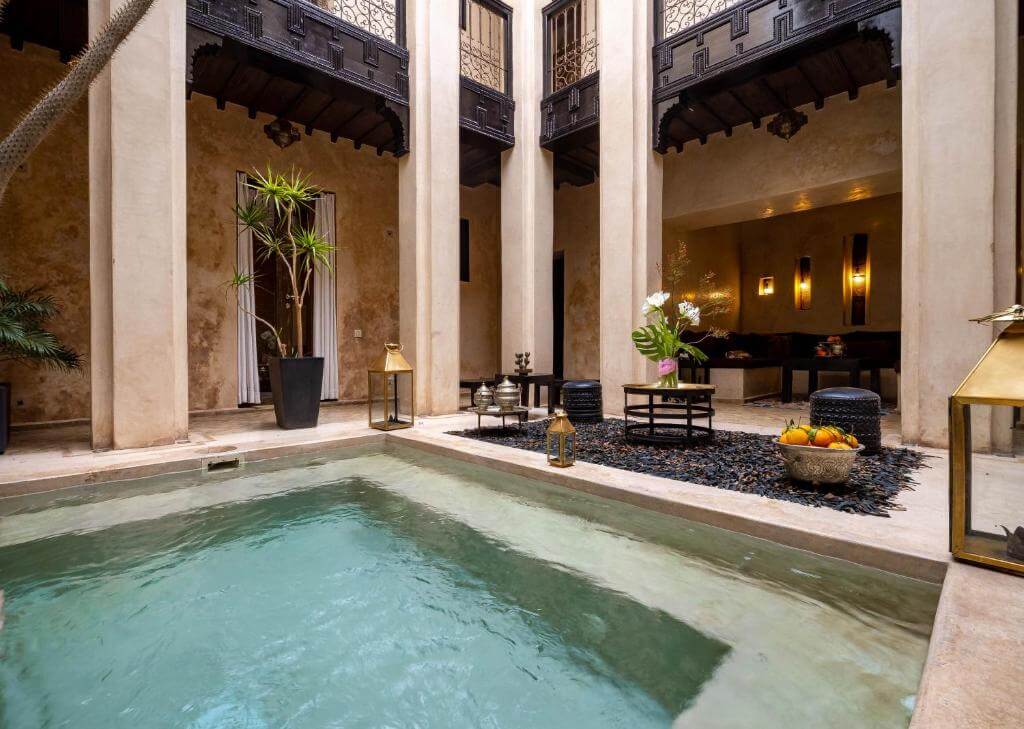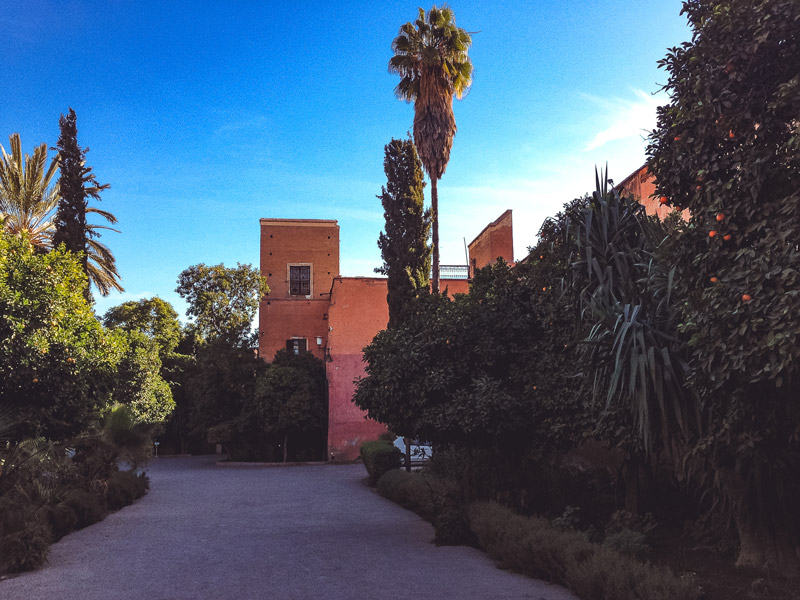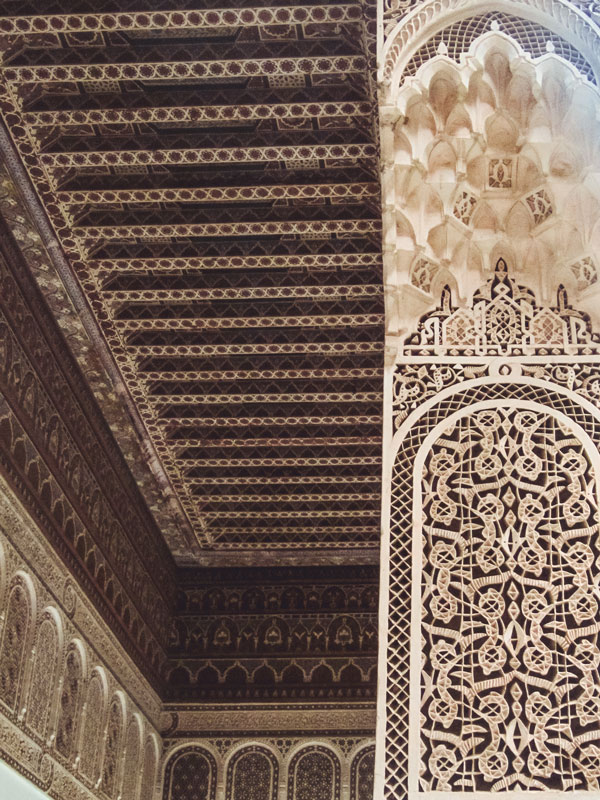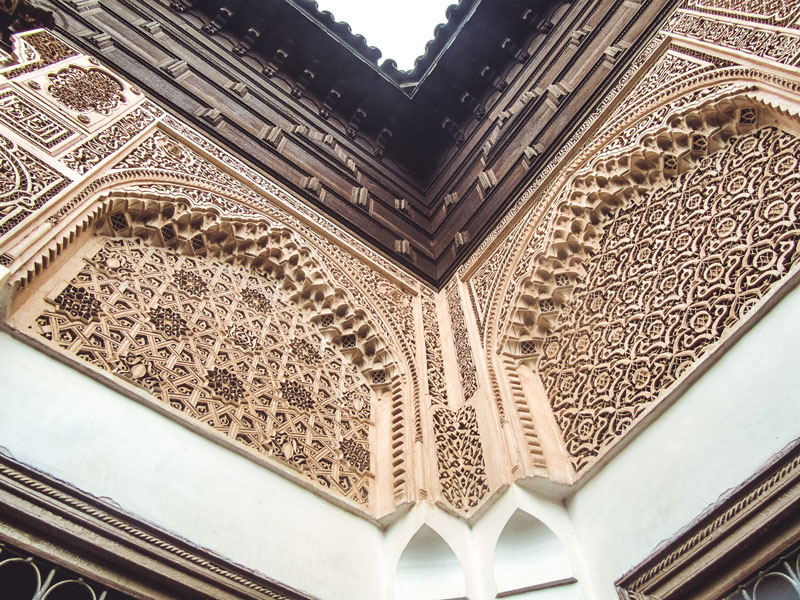The Bahia Palace stands on the southern rim of the Medina, just a short distance from the Mellah. The Alawids built this spacious complex in the latter part of the 19th century. The palace counts among Marrakech‘s most beautiful attractions.
The palace’s architecture hints at both Andalusian and Moorish influences. It has distinct echoes of the Al Hambra, in Grenada, Spain. Gracefully rendered stucco and intricately carved cedar wood ceilings are juxtaposed against ornate mosaics and decorative arabesques. An exquisitely landscaped garden trails through the centre of the complex, leading to a colossal courtyard with an entirely marble floor.
Contents
The Bahia Palace is spread out across a floorspace of some 8,000 m², with 160 rooms, riads und courtyards. Along its densely planted patios, the air is refreshingly cool and moist. The scent of flowers and orange trees lingers in the air. The atmosphere in this complex is utterly unique. For this reason, the Bahia Palace (Fra.: Palais de la Bahia) should count among the cultural must-sees for a stay in Marrakech.
History of the Bahia Palace in Marrakech
The Bahia Palace was built in the second half of the 19th century, at a time when the Alawids ruled Morocco. The building was originally commissioned by the Grand Vizier, Si Moussa, who led the government’s affairs on behalf of the Sultan, and this was reflected in its early name, Dar Si Moussa. It is particularly noteworthy that Si Moussa should have occupied the second most important position in the land, because the Grand Vizier was born of humble origins, as a dark-skinned slave. However, he grew up alongside the Mulai al-Ḥasan I, the heir to the throne, who later appointed him as his chamberlain.
To this day it remains unknown exactly when building work on the Bahia Palace began. What is known, is that the architect concerned was kept under contract from 1859 to 1873. In the earlier stages of its construction, the palace was significantly smaller. However, some years later, in 1894, the building was extended considerably by Moussa‘s son Bou Ahmed, who had by then been appointed head of the government by Alawiden-Sultan Abd al-Aziz. Bou Ahmed appointed Mohammed bin Makki to oversee the build. He was regarded as a star architect at the time and had also worked in Andalusia. An influence, which is evident in the Bahia Palace.

It took thousands of craftsmen, labouring for more than seven years, to complete this monumental edefice. Little wonder, that it now counts as the largest palace of its era. The necessary materials were transported here from throughout Northern Africa. The finest Italian marble was imported from Carrara. Under the stewardship of Mohammed bin Makki, the little riad, a hammam, a mosque, the place of honour and the magnificent gardens which brings each of these elements together were finally completed.
After the death of Bou Ahmed, the time of the Protectorate followed
The Grand Vizier Bou Ahmed died in 1900. In the wake of his passing, the palace was looted, and his treasures were stolen. The leaden era of the French Protectorate was to follow. The French employed the Bahia Palace as the centre of their new administration, and the French Governors also resided here. The most famous among them was General Hubert Lyautey, who was to play an important role in the cultural history of Marrakech. It was during his tenure that the Saadian graves were rediscovered.
Since the end of the colonial era, the palace has remained in the possession of Morocco’s kings. The palace is the first historical monument of Morocco‘s modern era. At the beginning of the 2000’s the Bahia Palace was extensively restored. Since then, this imposing structure has shone with a renewed splendour. A second phase of renovations has also been completed in the interim.
The construction of the Bahia Palace
The path between the outer palace walls and the entrance to the Bahia Palace proper is lined with palms, yuccas, citrus trees, cypresses, hibiscus trees trailing jasmine. The scent of oranges lingers everywhere. A sophisticated labyrinth of ornately decorated rooms, small courtyards, beautiful gardens and water features follows. The Andalusian-Moorish influences dominate throughout.
Almost all of the palace‘s 160 rooms are opened to the public, although many of them are now empty. Even divested of their furnishings, the palace chambers convey a powerful sense of the luxury once enjoyed by Grand Vizier. The generosity of the proportions and the refinement of the interplay between architecture, art, light and plants is quite overwhelming.
The Bahia Palace consists of four main parts: the large riad was built during the first phase of construction. The small riad, the large courtyard, the garden and the private apartments were added subsequently.
The small riad
The first building you will enter during a tour of the Bahia Palace is the small riad. It is set in the centre of a square-shaped garden, filled with lush plants. With its classical structure and elaborate decorations of stucco and cedar wood, the riad leaves quite an impression. Bou Ahmed consulted his advisors in the Council Chamber, which is also in this part of the complex.
Three hallways feed into the riad’s inner courtyard. The eastern corridor leads to a common room. From here, it leads through a foyer – with a stunning mural on its ceiling – and on into the magnificent inner courtyard of the original palace. During the time of the protectorate, the French installed several fireplaces in the Bahia Palace’s small riad and connected electricity.
The small courtyard
This part of the complex is comparatively minimalist in its design. The white walls are largely unadorned. The floor consists of white Carrara marble. In the centre stands a fountain, encircled by tiled mosaics. These tiny, carefully positioned ceramics are particularly characteristic of Morocco. The technical term for this art is Zellij. Four rooms open out onto the courtyard: each was once occupied by one of the four wives of the Grand Vizier. The buildings in this part of the palace are more modestly decorated than the two riads. Other than the mosaics, the only notable features are the cedarwood ceilings and the beautifully carved doors.
Bou Ahmed is believed to have named the Bahia Palace in honour of his favourite wife. In Arabic, “Bahia” means the shining, or the gleaming one.
The large courtyard
The so-called Courtyard of Honour (Cour d’honneur) is particularly impressive. It was completed in 1898/99 and assumes grand proportions, occupying an area of some 50 by 30 metres. The courtyard is completely lined with marble. It is surrounded by as many as 80 rooms, built to house the concubines of the Grand Vizier’s harem. These women did not enjoy a particularly high social status during their time, nor did the eunuchs who guarded the harem.
The large riad
The large riad is located on the northern side of the Courtyard of Honour. This was the original palace of Si Moussa. The oldest part of the Bahia Palace consists of a large garden with views across two alcoves and two large rooms. The ceilings are carved from cedar wood and embellished with decorative patterns.

To the west and the east of the large riad, there are further chambers, which are fitted with fireplaces and decorated in the typical Zellij style. Once again, the wooden ceilings are beautifully painted. Near the palace gates, there is a private apartment. This was built in 1898 for Bou Ahmed‘s first wife, Lala Zinabe. Here, too, there are masterfully painted ceilings, elaborate stucco decorations and stain-glass windows.
In the large riad, the eye is immediately drawn to the Maschrabiyya; ornate latticework carved from wood, in the strictly geometric patterns that form typical elements of Islamic architecture. These serve not only to shield the sunlight, but also provide a little privacy, functioning in a similar way to a jalousie-style blind or shutter. They also help to moderate the temperature, removing the need for glazed windows.
The Bahia Palace Marrakech is – and yet isn’t – a prime example of Islamic architecture
When considered from an Art History perspective, the Bahia Palace presents some contradictory elements. One the one hand, there are some superb and familiar examples of Islamic architecture in evidence. These include the refined positioning of visual axes between the buildings, the bold geometrical symmetry of all shapes and the landscaped gardens with their reflected light and water features.
But above all, there is the indescribable delicacy of the handwork, the result of years of careful toil by thousands of artisans and craftsmen. This is reflected time and again, from the perfection of the mosaics to the perfectly rendered carving and stucco work.
And yet, within the Bahia Palace, there are also many instances where the fundamental rules and principles of Islamic architecture are betrayed. The living areas and courtyards are unevenly distributed. At times, it is as though they are connected by an almost arbitrary association of corridors and stairways. There is no sense, in these places, of an holistic, guiding principle.
An explanation for this lies in the palace’s history, because its expansion meant accomodating the existing buildings within a limited space. In this context, certain compromises regarding traditional forms and practices were unavoidable.

None of this detracts in any way from the overall appeal of the Bahia Palace, quite to the contrary. Indeed, without the expansions undertaken by Bou Ahmed, the Bahia Palace would be far less impressive.
The Bahia Palace today
It was only a matter of time before the film industry became aware of the Bahia Palace. Films such as The Desert Lion or Lawrence of Arabia (1962), Cent mille dollars au soleil (1964) transformed the Bahia Palace into a cinematic location. Moreover, the UNESCO recognised it as a UNESCO World Heritage site.
The palace complex continues to serve various functions, in addition to its role as a museum. Cultural exhibitions such as the Biennale Marrakech 2016 take place here, in addition to numerous concerts. To this day, foreign dignitaries and highly decorated guests are received at the Bahia Palace.
Conclusion: One of Marrakech’s most beautiful sights
Without question, the Bahia Palace is among the most beautiful attractions in Marrakech. Nowhere else in Morocco can one experience the country’s architecture on this scale or at this level of perfection. One may find comparable craftsmanship in the Museum Dar Si Said or the Ben Youssef Madrasa. But neither of these locations can compete with the sheer size and scale of the Bahia Palace.
Practical information
For a comprehensive tour of the 8000m² Bahia Palace, aim to allow at least one and a half hours. Despite some signage, navigating your way around this immense complex can prove disorienting. I managed to visit the palace on two occasions, without ever seeing the Courtyard of Honour! And both visits were still well worthwhile.
For this reason, it is not unreasonable to consider hiring one of the local guides that hover around near the entrance area. For a small fee, they will be able to guide you throughout the complex.
Alongside the Ben Youssef Madrasa and the Jardin Majorelle, the Bahia Palace counts among Marrakech’s most-visited attractions. Consequently, there are often a lot of tourists here. If you would like to visit at a quieter time and perhaps take some photos, there is really only one solution: visit first thing in the morning, arriving punctually before the palace opens at 9am. Any time later, and it quickly becomes crowded.
Location:
The Bahia Palace is located in the south eastern part of the Medina. From Jemaa el Fna, it can be accessed via the Riad Zitoun el-Jedid. The complex has wheelchair access, with some restrictions.
- Rue de la Bahia, Médina Marrakesch
- Google Maps
Opening times:
- Daily 9 – 18 hr
Entrance fee:
- 70 DH (as of 01.08.2018), 20 DH for locals















